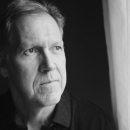Today's readers struggle with the Bible. Long, complex sentences, old fashioned "holy" words, and page after page of plain paragraphs make for difficult reading. Over the past 50 years, translators have tackled the problem by developing less literal translations. These make it easy to grasp a superficial understanding of the text, but do not offer the entry into deeper understanding that a literal translation provides.
While literal translations present a higher risk that the reader may completely miss the meaning, they have a higher possible reward of showing the reader something that would not be apparent in a dynamic translation or a paraphrase. The Readable Bible translation is slightly more dynamic than the ESV and NASB, and less so than the NIV. The text is presented in modern formats to lower the risk of misunderstanding and to increase the probability of greater understanding.
We are honored to be able to chat with The Readable Bible's creator Rod Laughlin for this exclusive interview. Laughlin has served the Lord as the pastor of two churches and in many other ways for thirty-seven years, he sensed God's call to put the Bible into modern formats. He has spent the last fourteen years leading a team to create The Readable Bible. Over one-hundred people have worked with him on this project.
Q: What is your role behind the Readable Bible?
As the initiator, founder, and manager of the project, my role was multifaceted. My first step was figuring out what a Bible in modern formats would look like. I translated the Pentateuch, Ezra, Nehemiah, Psalms, and the New Testament and organized them into modern formats. Then, having figured out what The Readable Bible would look like, I developed a team to support its creation. Clyde Adams came on board as my graphics partner. He designed the book layout and made my map drawings into professional maps. Then Dr. Brendan Kennedy joined the team as lead translator. He reviewed all my work and then translated the rest of the books of the Old Testament. About twenty-five others joined the team to review our translation and formatting, proof the work, and make suggestions to improve it.
I engaged Bott Radio Network to broadcast our need for a volunteer development team. Over four hundred Bott Radio listeners joined, from scholars with a PhD to lay people who love the Word of God. They read each book and made many helpful suggestions to improve readability. I was part of the team that reviewed the suggestions and decided which ones to incorporate into the text.
Q: What was the inspiration behind The Readable Bible?
God was. When returning from a mission trip to Afghanistan, I was looking for a book to read in an airport bookstore. I sensed God asking me, "Why are you looking for a book to read? You have a Bible in your briefcase." I replied, "The Bible is hard to read." The response came: "Why?" I had no answer. So I went over to the nonfiction section and paged through some books. I immediately noticed the variety of formats they used. I realized that today we use different formats to present different kinds of information. If you look for a genealogy, you find a table, not a paragraph of sentences. Who ever heard of such a thing? Yet in the Bible we expect people to read who gave birth to whom in sentences! And all today's Bibles use sentences to present object specifications (e.g., the tabernacle furniture, law code books, camp layouts, lists of items, etc.).
That's when God called me to create a Bible in modern formats, formats that make it easier to understand the meaning of the Bible's words.
Q. What do you mean by "modern formats."
The meaning of modern formats has changed over time. A few hundred years after the Torah was written "modern format" would have meant writing with dots or lines as markers between the words. There were no vowels in that text. In the sixth century, a new format was developed, one with diacritical marks. The marks illustrated how to pronounce the words (in effect, adding vowels). The whole Hebrew Old Testament was in this format by the end of the tenth century.
In the years after Christ, neither the Hebrew nor the Greek biblical texts had spaces between words. Spaces were not added until the seventh century AD. Verse numbers were not added until the thirteenth century, but the first system was eventually rejected in favor of one developed in the sixteenth century.
Before The Readable Bible, the last complete reformatting of the Bible was in 1873, when Cambridge Press brought out the Cambridge Paragraph Bible. The text was fully paragraphed, and poetic text was presented in verse lines.
Today, in The Readable Bible, our modern formatting includes tables (census, genealogical, tabular), graphic formats (layout drawings, sketches), cascading text, images (pictorial representations of letters and proclamations), and many other designs. These formats make it much easier for the mind to grasp information and see how one fact relates to another.
Q: We already have many translations, why is there a new need for another version?
There is no need for a new translation; there is a need for a new presentation-new formats. We created a new translation only because no existing one would let us format their text in a completely modern way. The Readable Bible translation is very literal, close to the ESV, NASB, and other literal translations. I don't think of it as new. I think of it as newly formatted.
But was this reformatting necessary? I am not the one to decide that. Believers will decide if they want it, if it is useful. I believe God directed our team to do it and directed our work. So I believe there must be a need.
As you think about the answer to this question, let me ask you: "Have you read through the whole Bible?" If you say, "Yes," let me ask you another question: "When you read the first nine chapters of 1 Chronicles, did you read all 279 occurrences of 'son of,' 22 of 'the descendants of,' and 110 occurrences of 'fathered' and understand how the names after those phrases related to each other?" Not likely. You probably skimmed over those 53 paragraphs and have no idea how the over one thousand people named relate to one another. And if you put the paragraphs in front of you and try to figure it out, it is a time-consuming, wearying task. But when you see all the names formatted in genealogical tables as in The Readable Bible, you see how people related to one another. You see things you never saw before, and the text becomes interesting. Instead of being put off by it, you feel drawn to explore and understand it.
Did you know that Romans 3:1-4:12 consists of twelve questions, along with their answers and explanations? With plain paragraph text you find yourself reading disconnected sentences. With structured cascading text the flow of Paul's arguments jumps out at you, and you find yourself engaged and enjoying what he wrote.
When you are looking for the letters to the churches in Revelation, how do you find each one? In The Readable Bible you flip the pages and immediately discover each on a separate piece of parchment.
Most people are not aware that in Exodus, right after the Ten Commandments, there is a law book, "The Book of the Covenant." In The Readable Bible it is obvious because it is presented on parchment background. And it is clearly a law book because it is formatted in outline form with Roman numerals, lettered headings, and numbered divisions. Since it is a book within the book of Exodus, it has its own contents table.
I am constantly getting comments from people saying they sat down to read a chapter or two and found themselves reading several times what they had planned to read. The indications are that there is a need for The Readable Bible.
Q: How is The Readable Bible different from other translations?
Since it is primarily a literal translation, my guess is that most of the phrases in our sentences have a virtually identical phrase in some other translation. Since The Readable Bible is the most recent translation, there is some freshness, some use of words that reflects today's English better than older translations. But we did not set out to break ground with words. We set out to break ground with formats that make it easier to understand the words.
There are two words that we do translate differently than other Bibles. The Hebrew word hinneh and the Greek word idou may indicate an emotional moment, bring focus, and/or record a personal reaction to the situation. Old translations said "Behold," and "Look" is used in more modern ones. The Readable Bible expresses it with a word or phrase such as "look," "notice," "pay attention," "believe me," "suddenly," and "was surprised to see." While it is common for modern translations to ignore the word, The Readable Bible almost always renders it.
Also, we have been very careful to footnote the literal translation of every phrase where we present a thought-for-thought translation. For instance, Psalm 145:21 says, "Let all flesh bless his holy name." "Flesh" does not communicate well to today's audience. So The Readable Bible renders, "Let all living things bless his holy name." Since we departed from the literal text and made a decision of our own, we have a footnote that reads, "Literally: 'all flesh.'"
So when a person reads The Readable Bible they have a literal translation, but the formatting makes it as easy to read as a paraphrase-even easier.
Q: What is the theology behind this translation?
We have been careful to ensure that the translation does not reflect the salvation, eschatology, or other theology of any denomination. Our team has representatives from most of the major evangelical denominations. As much as possible, it is theology free. However, every member of our team believes that the Bible is the literal Word of God, that it is "inspired by God"-that is, "God-breathed" (the most literal translation of the Greek verb theopneustos). So we have labored to ensure all of God's Word is on the pages.
Q. Should the Bible be in modern formats?
The history of Bible formatting is fascinating. The Bible's appearance has changed throughout history, up until about 150 years ago, when all formatting innovation stopped. So today's Bibles look like they did 150 years ago. But no other nonfiction book today is formatted like books were formatted in 1873. The Bible is the only English book where you can find genealogies, census tables, and object specifications in sentence/paragraph format. Today, each type of information has its own common format, and people are used to seeing information presented that way. What sense does it make to present information in the most difficult to comprehend format, especially information as important as God's instruction for our lives?If we want people to understand the Scripture, we need to present it to them in the most understandable format.
Q: Who is this Bible's target audience?
At first I thought it would be new Bible readers. But as we have been developing it, we have discovered that people who have been Christians for many years are finding it just as valuable as new believers. Many who read their Bible every day have told me that, when they sit down to read a few pages, they read many. One person intended to read three chapters of Deuteronomy and stopped reading when he discovered he was in chapter 12. It is so easy to read The Readable Bible-people read more. So I'd say it is for everyone.
Q: Are there any parts of this translation that have helped you personally?
For years I was embarrassed to admit that I did not enjoy reading Psalms. I didn't see the poetry, the rhythm. So when I translated them I formatted them in cascading text, laying out the parallelism visually. Now I see the meter and the flow as I read, and I love The Readable Bible Psalms. I'm so happy to find joy in such a major part of God's special book.
To find out more about The Readable Bible, click HERE.



















